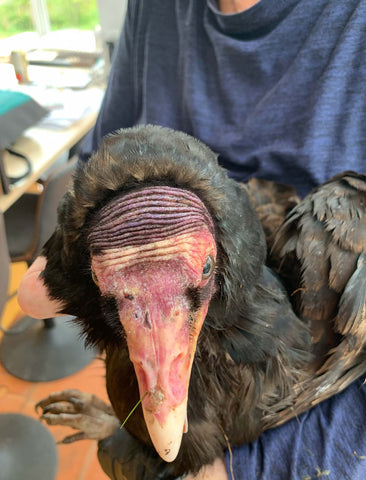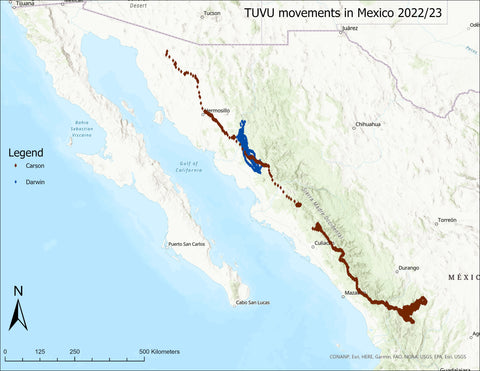This is a guest blog authored by Gill Radcliffe, wildlife biologist and founder of British Columbia-based Pacific Northwest Raptors and Master's student Cara Herrington, University of Victoria.
At Pacific Northwest Raptors (PNWR; often referred to as “The Raptors”), we have always held vultures of all kinds in awe; their mastery of soaring is truly inspiring, and their obligate scavenging habitats provide critical ecosystem services. We believe they are seriously undervalued!
We have only one native vulture species on Vancouver Island, the Turkey Vulture (Cathartes aura). These migratory vultures first appeared approximately 6 decades ago and they have steadily increased in range and numbers here ever since.

Turkey Vulture “Jury” helping us with education at our Raptor Centre in Duncan, British Columbia.
In British Columbia, Turkey Vultures occupy the most extreme northwest portion of their broad range in the Americas, and they continue to expand. In fall, the birds migrate down through the island and “bottleneck” near the southern tip, where hundreds to thousands can be seen waiting for conditions to be conducive to making the 20km (or more) ocean crossing to the US, on their southward journey.
Gill has always wanted to learn more about this aspect of TUVU's , and submitted a proposal to study their local ecology, migratory movements, and health in the Pacific Northwest. PNWR is also collaborating with other organizations (Hawk Mountain and Coastal Raptors) on this work, and has additionally partnered with the University of Victoria, and Master’s student Cara Herrington has joined the study.
Delayed by Covid-19, in May 2022 we finally began our quest to learn more. With assistance in the field by Dr. Dan Varland of Coastal Raptors we trapped our first two Turkey Vultures on a farm in the Cowichan Valley, and fitted them with Cellular Tracking Technologies (CTT) ES-400 transmitters (backpack mount). An additional brief session in early August resulted in another Turkey Vulture trapped, but it was in below average body condition, so no transmitter was deployed.

Dan at edge of bow net set.

Walk- in vulture trap.

Dan, Allan, and canine helpers in the field.
Since then, we have logged in eagerly to the CTT website almost daily to find out what the tracked vultures “Darwin” and “Carson" have been up to. (We have a long list of famous naturalists to inspire names for our study birds!) We are thrilled that, while we trapped the birds separately, both remained in our local area in the valley throughout the summer, rather than heading on further north, as many do. This local summer residency has greatly facilitated investigative field visits to well-used habitats.

Darwin is a bit of a scrapper.

Dan and Gerard with Carson.

Carson wearing his ES-400 unit.
In June, many days with no satellite connection and thus no GPS points from Carson had us pretty worried. We speculated that just maybe Carson was on a nest in a cave, below rock, but thought this would be too good to be true. However, ground searches located a cave nest and, sure enough, Carson was incubating! Monitoring cameras were placed on nearby trees and much to our excitement, a single chick emerged from the cave in July. We were able to collect thousands of pictures of chick/parent interactions over the subsequent month.
This snipper shows Carson feeding the juvenile TUVU in mid-July 2022.

Fluffy chick with Carson in front of cave entrance on 19/07/2022.
One or both parents continued delivering food and the chick grew, flexed its wings, and flew. We had hoped to fit the juvenile with a transmitter too, but waited just a few days too long; despite residual localized fluffiness, this fledgling was already highly mobile and flying strongly! It is a fine line to get the timing right on transmittering a juvenile bird, as too early would be detrimental to the youngster.

Carson feeding the chick on 20/07/2022.

Same chick in front of cave on 28/07/2022. Note all the use of surrounding rocks now.
We were a bit distraught. Gill headed down to the RRF conference in Florida and CTT staff were super helpful and reassuring. Still, we were checking in every day with a knot in our stomachs, as the signal stubbornly refused to appear. Finally, 12 days after the signal disappeared – bam! – there was Darwin again, well south in Mexico, near Ciudad Obregon. Feeling very relieved, we were really happy to find that the transmitter had been busy collecting the data throughout, so we now had all the info from the crossing of the Juan de Fuca Strait (a special focus of interest for us) all the way to the current locale.

Dr. Gill Radcliffe, CTT's Sales Specialist Jess Formento, and Dr. Dan Varland of Coastal Raptors at the RRF meeting in October 2022.
Meantime, Carson was still in the Cowichan Valley, but on October 9th she finally left. It took her only about 3 hours to reach the southernmost point of the island, where she was active in East Sooke and Rocky Point, and then poof, after only a day in that area, the signal disappeared. We were much less concerned this time, but after two weeks our anxieties grew – this was our locally breeding adult and we were worried! Finally, 18 days after “blackout”, there was Carson, just south of the Mexican border. Phew. Again, all the data had been collecting throughout, and we were delighted.

Tracks for Darwin (red) and Carson (orange) in fall 2022 (over 2 weeks apart).
Next Steps
Over the winter months we will conduct some preliminary data analyses and mapping, and will fine-tune some of our field data collection protocols and forms in readiness for a lot more trapping and transmitters next spring. We currently have 5 more units to put on, and we hope to have funds to order at least 3-4 more soon. We are also planning to scout the southern island in hopes of locating overwintering vultures in February. Persistent records in recent years on southern Vancouver Island suggest there is now always a small number overwintering on the island. But are these simply birds that tried and failed to cross, and then get stuck here for the winter? Or are we starting to see a few regular year-round residents? Noone knows yet, but we are hoping the CTT transmitters will help us find out!
Update, early February 2023:
During the month of January we took a couple trips down to Metchosin and laid eyes on some overwintering TUVUs. Most days we would see between 5 and 10 but one day, we saw 19! We have not gotten any transmitter data on this population yet, but we hope to be successful in trapping/tracking next winter. However, out of all of the TUVUs we saw during our outings there was only one juvenile and the rest were 2+ year olds. We thought this was a very interesting observation.
We have been watching Darwin and Carson closely during their time in Mexico. Darwin has been traveling back and forth between two locations in the Mexican state of Senora. They have stayed fairly high in the mountains and only cross into cell signal every few days for data upload. Carson ended up farther south in the very southern end of Durango, Mexico. Here, they were so deep in the mountains that they did not check in for over 80 days!
Needless to say, we were on the edge of our seats waiting to see when (or if) they would check in again. On January 15, 2023, Carson slowly started her journey north, but she did not check in for data upload until January 22nd when she appeared in Sinaloa, Mexico.
As of writing this Carson is now a mere 160 km from the Mexico/Arizona border. We are eagerly awaiting their arrival back on Vancouver Island! This map shows Carson’s home range in Durango and her movement northward. Darwin has yet to move north but their home range in Sonora is also shown.

